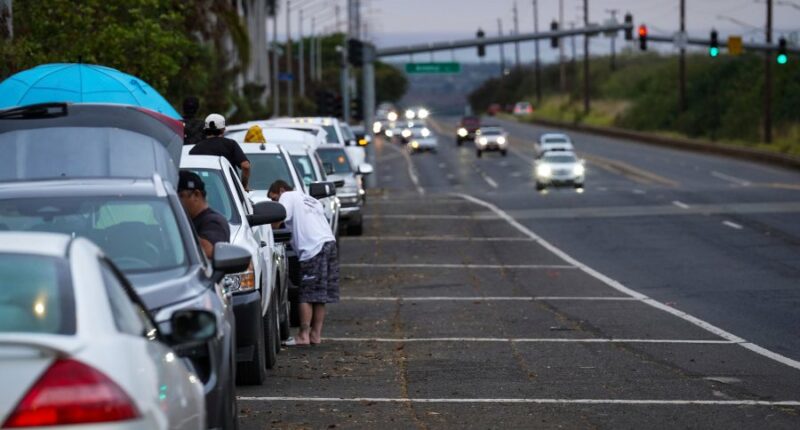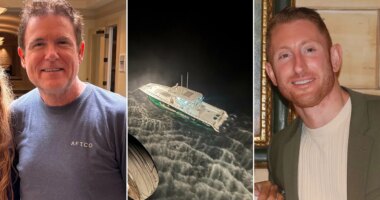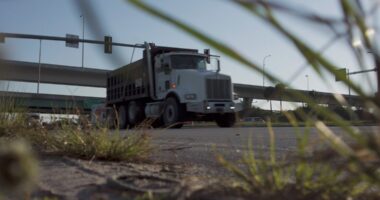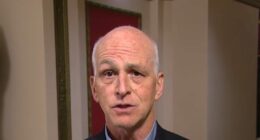Share this @internewscast.com

HONOLULU (AP) — While at home on the 31st floor of a Honolulu apartment, David Sun-Miyashiro was safe above potential danger when a notification on his phone alerted him to the possibility of a tsunami generated by a massive earthquake far across the Pacific Ocean.
With ample time before any potential surge reached Hawaii, he decided to do something he might not have risked in a more urgent situation: he got into his car to pick up his father who would need a lift to the airport later on.
His journey was short-lived. Traffic in Kakaako, his neighborhood, was locked down. Sun-Miyashiro spent an hour covering just a few blocks before he opted to turn back, eventually abandoning his vehicle and walking home with his young son in tow.
The tsunami caused by the 8.8 magnitude earthquake off a Russian peninsula resulted in minimal damage across the ocean. However, Hawaii officials noted that the earthquake occurring during afternoon rush hour, along with the extended warning time due to its distance, exacerbated traffic congestion in certain areas, hindering evacuation efforts that might otherwise have proceeded smoothly.
“It was definitely a bit of a wake-up call,” Sun-Miyashiro remarked, highlighting the vulnerability of densely populated areas where evacuation plans crumble if too many people simultaneously attempt to use their cars. “In such scenarios, you find yourself essentially stuck in place.”
‘Over-evacuation’ was an issue, officials say
A number of tourists opted for higher ground rather than staying on the upper floors of hotels as evacuation plans suggested. Some residents rushed to stores for supplies, while many others returned home after work to collect belongings or connect with family members before evacuating.
Additionally, some residents may have been confused about whether they really needed to evacuate, said Molly Pierce, spokesperson for the Oahu Department of Emergency Management.
There are standard tsunami evacuation zones, as well as zones for “extreme” tsunamis. Tuesday’s was a standard evacuation; some residents who live in “extreme” tsunami zones may have fled as well, even though they were already in safe areas, she said.
No need to hit Costco
Ed Sniffen, director of the state Department of Transportation, said Wednesday he doesn’t regret giving the public as much advance warning as possible. But next time, he would like to provide more education about how people should manage that time.
“That additional time, everybody tried to fill it. As soon as many heard about the event coming through, they tried to leave as soon as possible,” he said. “In other areas, people who were in safe zones, left those safe zones to go fill gas, went to go buy stuff from Costco or Safeway.”
It would have been more efficient for people to stay put if they were in a safe location, leaving the roads to those who needed to leave inundation zones, “and then make their way home in 20 minutes versus 2 1/2 hours.”
The state should also do a better job informing tourists that another option is simply to walk inland to higher ground, he said.
State Rep. Adrian Tam, who chairs the House Tourism Committee, said he was concerned about the gridlock in Waikiki, a legendary beachfront neighborhood that’s highly popular with tourists and which has only four roads in and out. He called it “a warning sign for the state and the city to look at ways to make things a little bit more organized.”
“I’m grateful that it wasn’t as serious as it could have been,” Tam said. “It does raise serious questions about how are we going to address massive gridlock.”
Hawaii usually has plenty of warning before tsunamis strike
Hawaii does not sit near the edge of a tectonic plate, but in the middle of the Pacific Plate. The major earthquakes that strike the state typically involve the weight of the still-growing volcanic islands bending and stressing the Earth’s crust and upper mantle. Rarely are those strong enough to cause a large tsunami, though a magnitude 7.2 quake in 1975 generated a tsunami that killed two campers on the Big Island.
The tsunamis that reach Hawaii usually arise from far-off earthquakes around the Ring of Fire — including in Japan, Alaska and Chile — and provide hours of lead time for evacuations.
On Tuesday, officials also took heed from the devastating wildfire in Lahaina, ensuring that a military road from Oahu’s Waianae Coast to the center of the island was open. A private road on Maui — commonly known as “Oprah’s Road” because Oprah Winfrey has an easement to use it — was also open for any evacuees who needed it.
‘I didn’t hear a car horn honk’
Jake Bacon, a freelance photographer from Arizona, was vacationing with his family at Bellows Air Force Station, a military recreation area on Oahu, when a security officer knocked on the door of their oceanfront cabin with instructions to evacuate to a military hospital partway across the island. It took him about 90 minutes to reach the hospital in traffic, and the family eventually wound up spending the night in a Safeway parking lot, where they had access to food and a restroom.
Still, he was struck by how orderly the evacuation was, especially compared to wildfire evacuations he’s witnessed.
“I didn’t hear a car horn honk,” Bacon said.
“Maybe a wave coming that’s not gonna be here for two hours is different than seeing the mountain on fire and knowing that it’s coming and worrying that you’re gonna lose everything you own,” he added. “But everybody just sat patiently and moved through traffic. Everybody acted in a way that just seemed, you know, how you would want it to be.”
___
Johnson reported from Seattle.
















